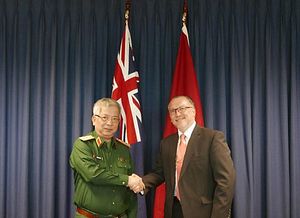One of the expected but nonetheless significant developments amid the flurry of activity tied to the ASEAN-Australia summit that took place this weekend was the official inking of a new Vietnam-Australia strategic partnership on March 15. Though this is just a single event within the broader history of ties, it nonetheless has significance both for bilateral ties as well as wider regional dynamics.
From the perspective of the bilateral relationship, the elevation to a strategic partnership marks just the latest of several boosts over the past few years. Formally, ties were initially elevated to the level of a comprehensive partnership in 2009 and then an enhanced comprehensive partnership in 2015. The intent to sign a new strategic partnership was confirmed during the APEC summit in Vietnam last year in line with the 45th anniversary of the establishment of diplomatic ties in 2018. Along the way, there have been several other developments, including the inauguration of the first defense dialogue last year (See: “Why the New Australia-Vietnam Defense Dialogue Matters”).
Viewed from a broader perspective, the move is significant in the context of both countries’ ongoing approaches to the region. For Australia, the fact that the inking of the strategic partnership came amid the holding of the first-ever ASEAN-Australia summit on Australian soil was a tangible demonstration that such multilateral engagements are also rooted in advancements in key bilateral relationships (See: “The Real Significance of the ASEAN-Australia Summit“). A similar dynamic was also at play with other countries within the regional bloc such as Singapore and Indonesia beyond the headlines (See: “What’s New About Indonesia’s ‘Push’ for ASEAN South China Sea Patrols?“).
For Vietnam, the new partnership is yet another sign that whatever Hanoi’s official line on alignments like the so-called Quad or strategic concepts like the Trump administration’s Free and Open Indo-Pacific vision, which was elaborated on during APEC last year in Vietnam, it is continuing to deepen ties with key partners like Australia, Japan, India, and the United States (See: “Trump’s Indo-Pacific Strategy Challenge“). The new strategic partnership comes right after some other notable developments, such as President Tran Dai Quang’s visit to India and the historic visit of a U.S. aircraft carrier to Vietnam (See: “Why a First US Aircraft Carrier Visit to Vietnam Matters“).
To be sure, the new strategic partnership needs to be kept in perspective. Though the official designation is important, the text of the joint statement officially adopted by both sides reflects a lot of the work already ongoing in the bilateral relationship in terms of political, economic, defense, people-to-people ties as well as wider regional and international cooperation, including the Plan of Action out to 2019.
It also does not undo old challenges, whether it be ones in the bilateral relationship, such as differences on democracy and human rights, or broader dynamics, such as Hanoi’s careful calibration of its foreign relations with Western states relative to its alignments with other actors like China, which continues to impose limits on how far it can go. But it is a sign of greater maturity in managing those challenges and a deeper confidence in pursuing new opportunities, which is itself notable.

































